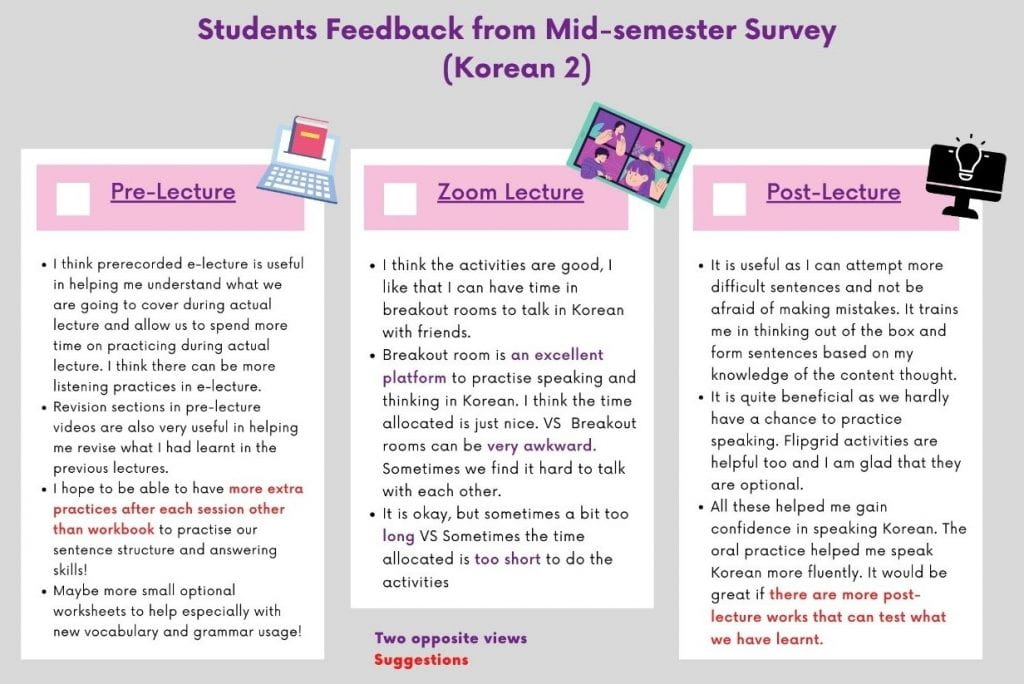PARK Mihi
Centre for Language Studies, Faculty of Arts and Social Sciences (FASS)
Mihi discusses her experience of developing a mid-semester feedback exercise to enrich
her students’ learning of the Korean language, including creating a post-feedback response video
to address some of the student feedback received.

Park, M. (2021, Sept 29). Creating a post-survey video in response to mid-semester student feedback. Teaching Connections. https://blog.nus.edu.sg/teachingconnections/2021/09/29/post-survey-video-for-mid-semester-student-feedback/.
Mid-term Descriptive Feedback
During the past five semesters, I implemented a mid-semester survey1 for the module LAK2201 “Korean 2” to collect descriptive feedback, which aimed to 1) provoke students to reflect on their own learning process, 2) empower students in teaching and learning activities, and 3) evaluate new initiatives. The three-part survey followed a weekly learning cycle (e.g. pre-, during, and post-lecture) which students could reflect on and describe their learning activities, including post-lecture works like weekly review notes2 and Flipgrid recordings3 (see Appendix for the survey questions).
Responses to the Survey Findings and Action Taken
The survey was conducted via LumiNUS, where students submitted their responses anonymously. After students completed the survey, I analysed and categorised the feedback collected based on degree of urgency and feasibility. I exercised care and deliberation in terms how I responded to those feedback, which included making changes in the course, explaining the rationale for incorporating certain (less preferred) learning activities, or giving students time to realise the pedagogical purpose of a certain part. Some immediate changes that I implemented encompassed fine-tuning and adding educational resources to aid students’ learning.
Additionally, I created a video to share my responses to the survey findings and the action taken. This video aimed to explain the pedagogical reasonings behind the new initiatives, and improvements made to the course based on the feedback. Producing the post-survey report as a video was inspired by work done by Cook-Sather et al. (2014) on building student partnerships in teaching and learning.
Here are samples of students’ feedback that I found constructive and informative (Figure 1).

Interestingly, to particular questions, the feedback was found to be bimodal, that is, students’ opinions were at two extreme ends rather than showing a one-way trend (see students’ feedback on Zoom Lecture in Figure 1). I carefully reviewed a number of meaningful and repeated-mentioned challenges highlighted in the student feedback, and addressed them in the course design. Here are few changes that I made for LAK2201:
- creating post-lecture quizzes on LumiNUS
- re-designing the group work to paired work, and
- showing a pre-assigned time for the breakout room activities.
Creating the Post-survey Video
Figure 2. Excerpts from the post-survey video for LAK2201 “Korean 2”.
To prepare the 15-minute response video (Figure 2), I created simple PowerPoint slides first, and recorded a video using Panopto, which was then uploaded to LumiNUS. Out of 166 students taking LAK2201 in Semester 2, AY2020/21, 92 students (55%) viewed this video, indicating that some students responded positively towards this approach. After the survey exercise, many students became more proactive in putting forward constructive and timely feedback on teaching and learning for the course. For instance, one student suggested that she would enjoy more culture-related topics in the discussions.
During the end-of-semester student feedback exercise, I was happy to read positive feedback that made specific reference to this mid-semester feedback exercise. It is worth-noting that the students had been briefed and were aware of the aims and motivations behind implementing the mid-semester survey.
“Dr Park constantly seeks feedback from students to enhance [their] learning experience throughout the semester, and not just at the end of the semester.”
“Dr Park takes student feedback seriously and genuinely, asked for mid-semester feedback, implemented some suggestions e.g. changes to breakout room sizes, and made a video addressing the commonly raised feedback/comments.”
Concluding Thoughts
I found the experience of developing the mid-semester survey exercise to be a fulfilling one which facilitated the building up of an authentic partnership between the students and instructor. It also taught me how cultivating a strong teacher-learner partnership can have a positive impact in enhancing students’ learning experiences and the outcome. The benefits of such a partnership encouraged me to observe my students further and to actively interact with them to understand their learning progress. Students also appreciated the invitation to share their views, the instructor’s responsiveness to feedback, and the swift implementation of course-related changes. Indeed, the descriptive feedback encouraged students to reflect and share their learning with me, and also impacted their attitude towards their own learning.
Endnotes
- Since Academic Year (AY) 2020/21, NUS faculty are encouraged to implement mid-semester feedback. This report discusses the mid-semester surveys I implemented over the past five semesters prior to this development. Prior to AY2020/21, the official student feedback exercise at NUS was only collected at the end of semester, therefore students’ feedback may only impact a subsequent semester or cohort.
- The review note is a weekly reflection that students are required to write at each lecture.
- Flipgrid is an online tool that I used to additionally support an oral practice.
Appendix. Mid-semester Survey Questions
Here are the questions I asked students taking LAK2201 “Korean 2” in Semester 2, AY2020/21.
Section 1. Preparation work with pre-recorded e-lectures, and any other worksheets
1-1. How manageable is the workload?
1-2. How does the e-lecture help you with learning?
1-3. What kind of additional support would be needed for a preparation?
Section 2. The live Zoom lecture
1-1. How do you feel during breakout room activities?
1-2. Is there anything else you wish I do more or differently?
Section 3. Post-lecture homework
3-1. How do you use the review note in studying Korean?
3-2. How do you feel about Flipgrid activities, if you did it?
3-3. In what aspect, the assigned post-lecture works helped you?
 |
PARK Mihi is a Senior Lecturer at the Centre for Language Studies (CLS) at NUS. Her research interests include computer-assisted language learning programmes, multilingualism, and cognitive development through language learning. As a founding staff member of the Korean language programme at NUS, Mihi has been developing the curricula, materials, and assessments for these courses. Mihi can be reached at mpark@nus.edu.sg. |
Reference
Cook-Sather, A., Bovill, C., & Felten, P. (2014). Engaging students as partners in learning and teaching: A guide for faculty (First ed.). Jossey-Bass.

